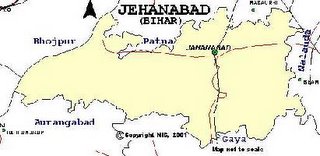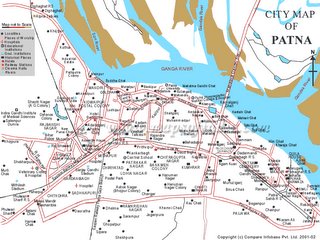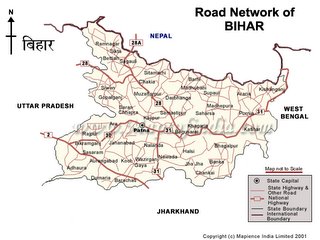The Bihar state has a magnificiently rich and ancient history.
Earliest myths and legends of hinduism the Sanatana (Eternal) Dharma - are associated with Bihar.
Seeta, the consort of Lord Rama, was a princess of Bihar. She was the daughter of King Janak of Videha. The present districts of Muzaffarpur, Sitamarhi, Samastipur, Madhubani, and Darbhanga, in north-central Bihar, mark this ancient kingdom.
The present small township of Sitamarhi is located here.
According to legend, the birthplace of Seeta is Punaura, located on the west-side of Sitamarhi, the headquarters of the district. Janakpur, the capital of King Janak, and the place where Lord Rama and Seeta were married, lies just across the border in Nepal.
It is reached via the rail station of Janakapur Road located in the Sitamarhi district, on the Narkatiyaganj - Darbhanga section of the North-Eastern Railway.
It is no coincidence, therefore, that the original author of the Hindu epic - The Ramayana - Maharishi Valmiki - lived in Ancient Bihar. Valmikinagar is a small town and a railroad station in the district of West Champaran, close to the railhead of Narkatiyaganj in northwest Bihar.
The word Champaran is derived from champa-arnya, or a forest of the fragrant Champa (magnolia) tree.
It was here that Prince Gautam attained enlightenment, became the Buddha- at the present Bodh Gaya- a town in central Bihar; and the great religion of buddhism was born.
It is here also that Lord Mahavira, the founder of another great religion, Jainism, was born and attained nirvana (death). That site is located at the present town of pawapuri, some miles to the south east of patna, the Capital of Bihar.
it is here that the tenth and last Guru of the Sikhs, Guru Gobind Singh was born and attained the sainthood of sikhism, that is became a Guru. A lovely and majestic Gurudwara (a temple for Sikhs) built to commemorate his memory - the harmandir- is located in eastern Patna. Known reverentially as the Patna Sahib, it is one of the five holiest places of worhip (Takhat) for Sikhs.
The ancient kingdoms of Magadh and of Licchavis, around about 7-8th century B.C., produced rulers who devised a system of administration that truly is progenitor of the modern art of statecraft, and of the linkage of statecraft with economics.
Kautilya, the author of Arthashastra, the first treatise of the modern science of Economics, lived here. Also known as Chanakya, he was the wily and canny adviser to the Magadh king, Chandragupta Maurya. As an emissary of Chandragupta Maurya, Chanakya traveled far and wide in pursuit of promoting the interests of the State and dealing with the Greek invaders settled in the northwest of India, along the Indus valley. He succeded in preventing the further onslaught of the Greeks. Indeed, he brought about amicable co-existence between the Greeks and the Mauryan Empire.
Megasthenes, an emissary of Alexander's General, Seleucus Necator, lived in Pataliputra (ancient name of Patna, the Mauryan capital) around 302 B.C. He left behind a chronicle of life in and around Patliputra. This is the first recorded account by a foreign traveler in India.
It describes in vivid terms the grandeur of life in Patliputra, a city established by King Ajatshatru, around 5th Century B.C., at the confluence of the rivers Sone and Ganga.
Another Mauryan king, Ashok, (also known as Priyadarshi or Priyadassi), around 270 B.C., was the first to formulate firm tenets for the governance of a people. He had these tenets, the so called Edicts of Ashok, inscribed on stone pillars which were planted across his kingdom. The pillar were crowned with the statue of one or more lions sitting on top of a pedestal which was inscribed with symbols of wheels. As the lion denoted strength, the wheel denoted the eternal (endless) nature of truth (dharma), hence the name Dharma (or Dhamma) Chakra. This figure of lions, atop a pedestal, with inscription of a wheel, was adopted as the Official Seal of the independent Republic of India (1947). Also, Ashok's dharma chakra was incorporated into the national flag of India, the Indian tricolor. Remains of a few of these pillars are still extant, for example at Lauriya-Nandan Garh in the district of West Champaran and at vaishali , in the present district of the same name. Ashok, a contemporary of Ptolemy and Euclid, was a great conqueror. His empire extended from what is now the the North West Frontier Province (in Pakistan) in the west, to the eastern boundaries of present India in the north, and certainly, up to the Vindhyan Range in the south. Ashok was responsible also for the widespread proselytization of people into Buddhism. He sent his son, Prince Mahendra, and daughter, Sanghamitra, for this purpose to as far south as the present country of Sri Lanka (Sinhal Dweep in ancient times, and Ceylon during the British Empire. Some historians, particularly Sinhalese, consider Mahindra and Sanghmitra as brother and sister.
Ancient Bihar also saw the glorification of women in matters of state affairs. It was here that Amrapali, a courtesan of Vaishali (the present district of the same name) in the kingdom of the Lichhavis, attained and wielded enormous power.
It is said that the Lord Buddha, during his visit to Vaishali, refused the invitation of many princes, and chose to have dinner with Amrapali instead. Such was the status of women in the Bihari society of several centuries B.C.!
A little-known, but historically and archaeologically documented, event is worth mentioning in this context. After his visit with Amrapali, Lord Buddha continued with his journey towards Kushinagar (also called Kusinara in Buddhist texts.) He travelled along the eastern banks of the river Gandak (also called Narayani, which marks the western border of Champaran, a district now administratively split into two- West and East Champaran.) A band of his devoted Licchavis accompanied Lord Buddha in this journey. At a spot known as Kesariya, in the present Purbi (meaning, East) Champaran district, Lord Buddha took rest for the night. It was here that he chose to announce to his disciples the news of his impending niravana (meaning, death); and implored them to return to Vaishali. The wildly lamenting Licchavis would have none of that. They steadfastly refused to leave. Whereupon, Lord Buddha, by creating a 3,000 feet wide stream between them and himself compelled them to leave. As a souvenir he gave them his alms-bowl. The Licchavis, most reluctantly and expressing their sorrow wildly, took leave and built a stupa there to commemorate the event. Lord Buddha had chosen that spot to announce his impending nirvana because, as he told his disciple Anand, he knew that in a previous life he had ruled from that place, namely, Kesariya, as a Chakravarti Raja, Raja Ben. (Again, this is not just a mere legend, myth or folk-lore. Rather, it is a historiclly documented fact supported by archaeological findings. However, neither this part of Buddha's life, nor the little town of Kesariya, is well-known even in India or Bihar.
At Nalanda, the world's first seat of higher learning, an university, was established during the Gupta period. It continued as a seat of learning till the middle ages, when the muslim invaders burned it down. The ruins are a protected monument and a popular tourist spot. A museum and a learning center- The Nava Nalanda Mahavira - are located here.
Nearby, Rajgur, was capital of the Muaryan Empire during the reign of Bimbisara. It was frequently visited by Lord Buddha and Lord Mahavira. There are many buddhist ruins here. It is also well-known for its many hot-springs which, like similar hot-springs elsewhere in the world, are reputed to have medicinal property.











